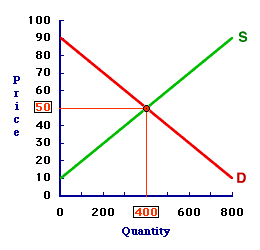A price ceiling places an upward limit on the price of good. Buyers and sellers can exchange the good at prices less than the ceiling, but not greater. The primary goal of a price ceiling is to keep the price of a good low and thus more affordable to the buyers.Price ceilings are most often placed on markets for goods that policy makers deem are basic necessities and that the existing price is excessive, perhaps due to market control among the suppliers. Examples of markets that have been subject to price ceilings include apartments, gasoline, natural gas, food, and prescription drugs.
How It Works
| Price Ceiling |  |
As luck would have it, the Shady Valley City Council has decided to impose a price ceiling on the market for 8-track tapes. The current equilibrium condition for this market is illustrated in the graph presented to the right. Without the price ceiling buyers and sellers trade 400 tapes at a price of 50 cents each. For some unknown reason, the Shady Valley City Council feels that 50 cents is simply too much to pay for 8-track tapes. Hence they have decided to impose a price ceiling of 30 cents on this market.To highlight this price ceiling, click the [Price Ceiling] button. The line drawn across the graph at the 30 cent price indicates this maximum price. With the price ceiling, the Shady Valley City County outlaws any and all exchanges at prices exceeding 30 cents.
What is the market to do?
- Supply Side: The sellers are willing and able to offer 200 tapes for sale at the 30 cent price, which can be revealed by clicking the [Supply] button. At 30 cents, suppliers can cover the production cost of 200 tapes. They are unwilling and unable to sell more.
- Demand Side: The buyers, however, are willing and able to purchase 600 tapes at this 30 cent price, which can be highlighted by clicking the [Demand] button. At this price, demanders can obtain at least 30 cents worth of satisfaction from 600 tapes.
- Shortage: The combination of the quantity demanded and the quantity supplied means that the market has a shortage of 400 tapes. The buyers want to buy 400 tapes more than the sellers want to sell. This shortage can be highlighted by clicking the [Shortage] button.
Good for Some, Bad for Others
The usual objective of a price ceiling is to keep a good affordable to the buyers. A 30 cent price ceiling on the market for 8-track tapes certainly accomplishes this goal. Those who buy 8-track tapes pay 30 cents each, rather than 50 cents. They save 20 cents on each tape. Good for them.There is, however, a bit of bad with this price ceiling. Prior to the price ceiling, 400 tapes are exchanged in the market. With the price ceiling, only 200 tapes are exchanged. Fewer tapes are exchanged. Moreover, given the low, 30 cent price, buyers are actually willing to buy 600 tapes, 400 tapes more than are offered for sale. While those who are able to buy the tapes do so at a lower price, a great many buyers do without. They are unable to buy at any price, low or high. Bad for them.
Although this particular market for 8-track tapes generates a substantial shortage at the 30 cent price, the shortage that might arise in other markets depends on the specific characteristics of the market. From a sheer graphical standpoint, the shortage is less if the demand and supply curves are more steeply sloped or less elastic. In other words, if the demand and supply are relatively inelastic, then the goal of keeping the good affordable, without excluding a lot of buyers from the market, is more easily achieved.
Illegal Exchange
Like any law, a legally mandated price ceiling can be violated. Some buyers and sellers are inclined to undertake illegal exchanges at prices above the legal maximum. The result of such illegal trades is termed a black market.| Illegal Trades |  |
Why would buyers and sellers risk legal punishment to engage in a black market?The price ceiling in the market for 8-track tapes displayed at the right means that 200 tapes are legally sold for 30 cents each. This creates the shortage, or excess demand, of 400 tapes. In a market with an unregulated shortage, buyers are inclined to bid up the price. While they are not legally allowed to do so with a price ceiling, the motivation still exists.
In fact, the motivation might be so powerful that buyers are willing to engage in illegal trades, to enter into a black market exchange. On the other side of the exchange, sellers are always inclined to accept more than the minimum supply price for a good. If the buyers offer more than 30 cents, then sellers are willing to listen.
The price, however, must be high enough to compensate the sellers for the risk of punishment. If the risk is slight, the price need not be much higher than 30 cents. If the risk is greater, then so too must be the price.
PRICE CEILING, AmosWEB Encyclonomic WEB*pedia, http://www.AmosWEB.com, AmosWEB LLC, 2000-2024. [Accessed: October 30, 2024].


